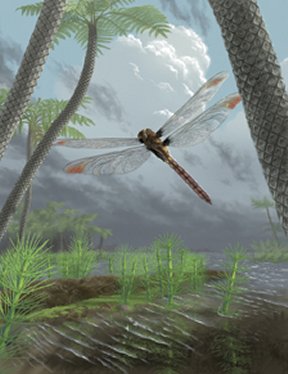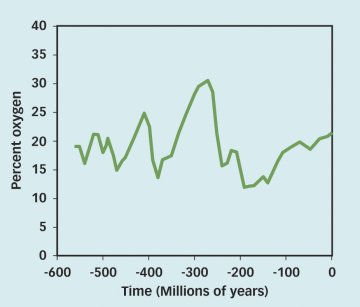As any camper who’s blown on a flickering ember can tell you, a campfire needs a steady source of air to stay alight. Without enough oxygen, the chemical reactions that release the energy stored in firewood falter and fail. When oxygen is plentiful, the release of energy proceeds apace. The same principles apply to metabolic processes: All animals require oxygen to extract energy from their food and to fuel their activity.


It’s no surprise, then, that during geologic periods when atmospheric oxygen concentrations have been high, biological innovation has blazed brightly. At such times, insects grew to gargantuan proportions, reptiles took to the air, and the forerunners of mammals developed a warm-blooded metabolism. When oxygen concentrations fell precipitously, biodiversity was smothered. Some of the planet’s mass extinctions occurred during or after geologically sudden drops in atmospheric oxygen.
Earth’s atmosphere had little if any oxygen until about 2.5 billion years ago (SN: 1/24/04, p. 61: Available to subscribers at Air held oxygen early on), after organisms began using chlorophyll to convert sunlight into useful energy. Because this reaction releases oxygen, the gas slowly became more plentiful in the atmosphere. The conversion of vegetation into coal and the burial of plant matter also puts oxygen into the atmosphere.
These boosts have been tempered by geological processes that remove oxygen from the air. Widespread episodes of mountain building were inevitably followed by extended periods of erosion and chemical breakdown of the newly exposed rocks, a process that consumes oxygen.
Atmospheric oxygen concentrations have risen and fallen—sometimes gradually and sometimes rapidly—at various times. To investigate how these changing concentrations have affected the world’s biota, scientists have most often looked to the fossil record. Now, lab experiments are fleshing out the ways in which animals respond to changes in oxygen abundance.
The need to breathe
Imagine a world populated by meter-long millipedes, mayflies with the wingspans of today’s robins, and dragonflies with wingspans rivaling those of hawks. This isn’t science fiction—it’s our world at the end of the Carboniferous period, about 300 million years ago. The atmospheric concentration of oxygen then probably was about 35 percent, an all-time high that far exceeds today’s 21 percent figure.
The Carboniferous abundance of oxygen enabled insects and other arthropods, which get their oxygen via diffusion through holes in their exoskeleton, to grow to immense proportions, says Robert A. Berner, a geophysicist at Yale University. Models of insect physiology suggest that the higher atmospheric concentrations of oxygen, as well as the increased air pressure that resulted, would have increased the diffusion rate of oxygen into an insect’s bloodstream as much as 67 percent.
The evolution of large-bodied arthropods occurred slowly but steadily as atmospheric oxygen gradually increased during the 60-million-year-long Carboniferous period. In laboratory experiments today, insects raised in oxygen-rich conditions can attain beefier proportions in just a few generations.
For example, fruit flies and mealworms raised in chambers for just one generation with twice the normal concentration of oxygen grew 3 percent larger bodies than those reared in standard conditions, says Jon F. Harrison of Arizona State University in Tempe. In other fruit fly-breeding experiments, low oxygen prevented the insects from becoming as large as other flies raised under normal or oxygen-rich conditions.
These findings, as well as evidence from the fossil record, suggest that the atmospheric concentration of oxygen tends to constrain the maximum size that an insect can attain, Harrison said in August at a Calgary, Alberta meeting of the Geological Society of America.
Experiments show that variations in oxygen abundance can also affect the development of reptiles, says John M. Vanden Brooks, a vertebrate paleontologist at Yale University. Under normal conditions today, eggs of the American alligator (Alligator mississippiensis) hatch between 65 and 70 days after they’re laid. In research that he reported at the meeting in Calgary, Vanden Brooks incubated alligator eggs in sealed, 20-liter aquaria in which he could control the oxygen concentration.
If the oxygen concentration was kept at 16 percent, embryonic development was delayed by almost a week. In experiments where the concentration was raised to 27 percent, development of the embryonic alligators was accelerated by almost a week.
At oxygen concentrations higher than 27 percent, mortality among the embryos was about twice that measured in eggs raised in a normal atmosphere, says Vanden Brooks. That higher death rate probably resulted from damage from oxidation of tissues.
Although the first reptiles evolved around 350 million years ago, and their descendants thus experienced oxygen concentrations above 27 percent, the first creatures resembling crocodiles appeared about 220 million years ago, when oxygen concentrations had dropped to about 16 percent.
Shortness of breath
The experiments on reptiles indicate that a precipitous drop in atmospheric oxygen could severely test animals that required high concentrations of oxygen to fuel an active lifestyle. Evidence from the fossil record bolsters that notion.
Most of Earth’s significant die-offs have occurred when atmospheric oxygen was rapidly declining or very low, says Peter D. Ward, a paleontologist at the University of Washington in Seattle. A 10-million-year nosedive in atmospheric-oxygen concentration straddles the largest mass extinction in the fossil record (SN: 2/1/97, p. 74). About 255 million years ago, near the end of the Permian period, the oxygen concentration stood at 30 percent. But it plunged to around 13 percent over just 10 million years.
“Something had wiped out the plants,” says Berner. Ecosystems once rife with large, woody, coal-forming trees gave way to systems dominated by small, herbaceous plants such as ferns. That change dramatically decreased the long-term rate of carbon burial in sediments. In general, for every carbon atom that’s sequestered in sediments, an oxygen atom returns to the air, Berner notes.
Die-offs that occurred at the end of the Permian and the beginning of the Triassic period claimed as many as 95 percent of the species living in the world’s oceans and about 70 percent of those on land.
At the end of the drop in atmospheric oxygen, its availability at sea level would have been similar to that today at an altitude of 4.6 kilometers (15,000 feet), says Ward. Today, a few yak, gazelle, and mountain sheep make up the wildlife at that altitude, but there’s far less diversity than at lower altitudes.
Just after the Permian-Triassic extinctions, most land animals lived only at low altitudes. That finding hints that the animals experienced oxygen stress, Ward noted at the Calgary meeting.
Fresh air
As the atmospheric concentration of oxygen rebounded after the end of the Permian period, so did life on Earth. The rise in oxygen abundance throughout the Triassic period, from about 13 percent up to 16 percent about 200 million years ago, permitted the evolution of several groups of organisms that had higher oxygen demands than creatures of the Permian did, says Lawrence H. Tanner, a paleobiologist at LeMoyne College in Syracuse, N.Y. The long-term increase in oxygen availability during the Triassic seems to have enabled biological innovation to flourish, Tanner notes.
For instance, the groups of relatively small reptiles that had survived the Permian extinctions evolved to become larger and more agile. Just 15 million years or so after the mass die-offs, the first dinosaurs appeared. The body plans of the creatures in this vanguard included hip and ankle adaptations that permitted an upright, bipedal posture and increased mobility. The higher concentrations of oxygen enabled such agile creatures to fuel their metabolisms, says Tanner.
The Triassic period saw the rise of the first flying reptiles, the rhamphorhynchoids. Analyses of fossils suggest that these creatures didn’t just glide, but also flapped their wings. Such a lifestyle would have required large quantities of food and abundant oxygen that could extract energy from them.
Ancestors of the first mammals also appeared in the Triassic. Besides having skeletal adaptations that suggested an active lifestyle, these creatures probably were the first to be warm-blooded, another oxygen-demanding metabolic feature.
Analyses of DNA from creatures living today suggest that placental mammals evolved between 100 million and 65 million years ago, a period when oxygen concentrations held fairly steady at 16 percent or so, higher than they had been at any time since oxygen abundance bottomed out about 200 million years ago.
A mammal’s highly developed brain, as well as its warm body, requires copious fuel. About one-third of a mammal’s energy supply goes to its brain, says Paul G. Falkowski, a biogeochemist at Rutgers University in New Brunswick, N.J. Pound for pound, mammals typically need three times as much oxygen as reptiles do, says Falkowski.
Because the embryos of placental mammals receive their oxygen via the mother’s bloodstream, only in an oxygen-rich atmosphere could a mother successfully nourish a growing embryo, Falkowski adds.
Starting about 50 million years ago, the atmospheric concentration of oxygen began to increase sharply. Over the next 5 million years, it rose to 21 percent. At the same time, the average global temperature skyrocketed, jumping about 7°C.
Both flora and fauna flourished under those conditions. DNA analyses suggest that the four major lineages of modern bats—flying mammals whose activity requires large quantities of oxygen—arose during this period (SN: 5/14/05, p. 314: Learning to Listen).
The rise in the concentration of oxygen continued, but at a slower pace, for several million years, says Falkowski. The ancestors of artiodactyls, the group that includes gazelles, cattle, and most of today’s other large herbivores, appeared during this interval.
About 25 million years ago, oxygen concentrations topped out at about 23 percent, around 2 percent higher than today’s value. By then, many mammals had become huge. Adults of some ground sloth species approached 5 meters in length. Indricotheres, which are relatives of today’s rhinos, stood 4.5 m tall and weighed about 15 metric tons—making them the largest land mammals ever.
After peaking, the atmospheric concentration of oxygen began its slide toward modern levels, and many of the world’s megamammals died out.
Gargantuan proportions are possible only in a high-oxygen world, says Falkowski. Because large animals don’t have as many capillaries per kilogram of muscle as small animals do, the bigger animals require higher oxygen concentrations to maintain a high metabolic rate, he notes.
Some mass extinctions, such as the disappearance of the dinosaurs 65 million years ago, have been pinned on the impact of an extraterrestrial object. But according to the recent data on atmospheric oxygen concentrations, many other die-offs may have been due to something as simple as a change in the air.






